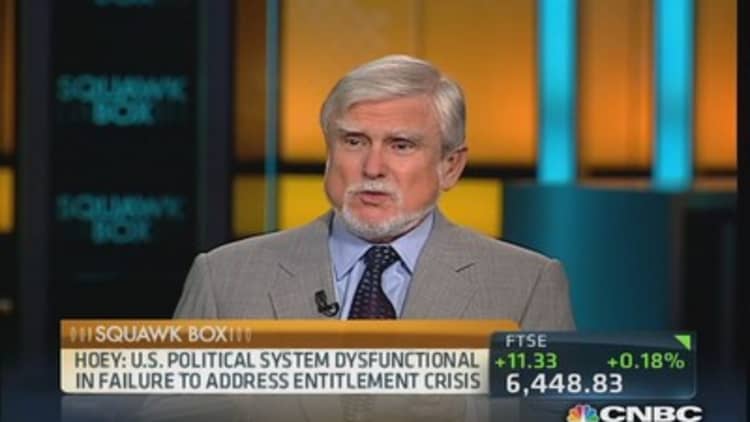The long slog sets in. Wall Street is quiet this morning as the reality that this will likely not be settled before the weekend at the earliest, and maybe well past.
Warren Buffett, on our air this morning, said we will go to the brink of "idiocy" but are unlikely to go over it. He was referring, I believe, to the debt ceiling, but then went on to say it might not be a disaster if we went over it as well.
This is it, in a nutshell: If it's short, it's not a big deal. If it's long--and by that I mean past the October 17th deadline for the debt ceiling raise--it's not priced in. That means we'll tread water until then.
Regardless: Washington is still the 800 pound gorilla in the room, and everything else is taking a back seat.

However, economic data still matters. The poor ADP figures dropped futures yesterday. Today, ISM Services checked in at 54.4, weaker than expected. Because ISM Services is done by a third party, the Institute for Supply Management, we got the number this morning.
The employment component--an important gauge of job growth--slipped to its lowest since May. The Manufacturing ISM employment component was a strong 57 last month, but the weaker Services number pours cold water on what some analysts were hoping would suggest a strong nonfarm payrolls figure. The current consensus is 180,000.
My point: even if we do not get a nonfarm payroll number on Friday, this number today will give us a flavor of the labor market.
More Fed speakers today: Dallas Fed President Richard Fisher speaks at 1:15 ET, and Fed Governor Jerome Powell at 1:30 ET. Boston Fed President Eric Rosengren yesterday got everyone's attention yesterday when he said he would be less inclined to start tapering if he didn't have good data.
Elsewhere
1) The NYSE/ICE merger is getting close. I noted last week that the NYSE/ICE merger was close to finalization, and yesterday the NYSE Euronext announced that the Committee of Euronext Regulators have not objected to the merger.
There's only one real hurdle left: final approval by the regulatory bodies in the five countries that Euronext operates in (the UK, Portugal, France, Belgium, the Netherlands). It's not clear when that will happen, but the betting is it will be soon, within the next couple weeks.
2) After two strong IPOs yesterday (Burlington Stores and ReMax) and one fair IPO (Empire Realty), all brand names, we have another brand name pricing tonight: Sandwich shop Potbelly (PBPB) is pricing 7.5 million shares at $11-$12 tonight.
3) The SEC is getting serious about trade data. SEC chief Mary Jo White gave her first speech on market structure yesterday at the Securities Traders Association conference in Washington.
Market structure (which looks at how our trading systems operate, or in some cases don't operate) isn't normally a headline-grabbing topic, but Ms. White did make an important announcement: the SEC is going to open a new website that will focus on market structure to serve as a central location to share data and research.
Ms. White touted the recent acquisition of a trade-information system called Midas, which the SEC bought from Tradeworx last year. The system allows participants to see much more information about what is trading than is normally available.
Ms. White said the SEC would make the information available to the public, so that research could be done on how the markets are trading.
How much? Midas collects one billion trades a day. Ms. White says "The web site will allow users to explore key market metrics and trends based on aggregate analyses of tens of billions of MIDAS records over the last year."
That's a lot more information than we have ever had before. Based on my discussion with individuals around the project, it may not include data in real time, but it will likely include yesterday's data, and data going back many years.
What kind of data? Today most traders can only see price and volume. This information will likely be much more robust: you'll be able to see total number of new orders, and the total number of cancellations....all broken down by exchange.
This is a big advance and will help answer a lot of questions that, up to now, haven't been able to be easily answered. For example: how long orders last in the system, and the rate of order cancellations.
That's important: there have been allegations that some high frequency traders have abnormally high order cancellation rates; some have alleged that these could be used to manipulate other market participants' orders.
Bottom line: there will be more trading data available that will generate better information on what kind of trading is being done. What you won't be able to see, I am told, is who made the trades. That will remain anonymous to everyone except the SEC.
Still, this is a positive step forward, even if much of this will be used to support staff research papers on who is trading what.
—By CNBC's Bob Pisani


